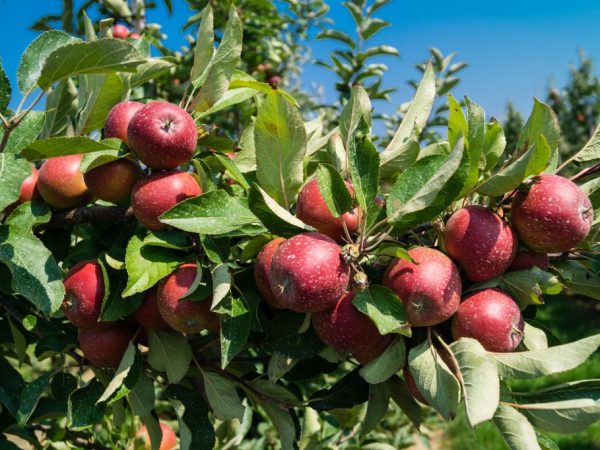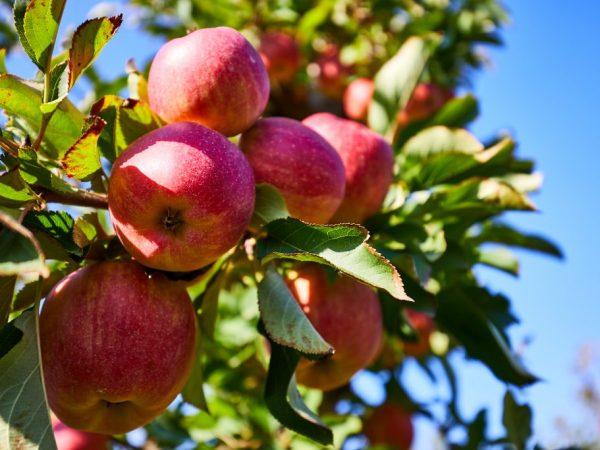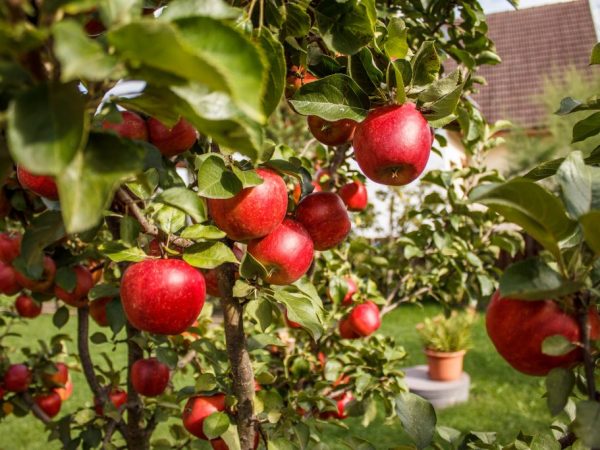Red apple varieties: the best varieties
Red apples improve metabolism, help cleanse the body of toxins. Vitamins and microelements have a more accessible formula - the percentage of their assimilation is much higher than pharmacy counterparts. To use the fruit correctly, you should learn more about their characteristics, containing large doses of pectin.

Red apple varieties: the best varieties
Beneficial features
Scarlet and burgundy shades on the peel of apples indicate the presence of anthocyanins, which are responsible for the normal function of immunity, high resistance to pathogens.
Natural pigment provides protection against ionizing radiation that provokes cancer.
The presence of all water-soluble B vitamins strengthens the nervous system, while fat-soluble A, β-carotene, E prolong youth and support the skin's ability to regenerate.
Composition
Red apple varieties differ from green and yellow ones. Basically, this is due to the fact that they have more carbohydrates, so it is undesirable to eat the fruits in the evening, otherwise nutrition will affect body weight.
KBZHU does not differ much, but the indicators are worth finding out in order to correctly compose your diet.
| Glycemic index | Simple Sahara | Energy value | The nutritional value | BZHU |
| 5-6 g fructose | 4.7-20 g | 200-218 kj | 47-54 Kcal | 0 / 0.38 / 10-15g |
Harm
The abundance of nutrients does not exclude the possibility of harming the excessive use of sweet treats.
Who should limit the daily portion of bright red apples:
- persons prone to allergic reactions;
- peptic ulcer, gastritis, irritable bowel syndrome;
- when losing weight, it is not recommended to eat more than 200 grams of fruits per day;
- people with type 1, 2 diabetes should introduce fruit into the diet with the permission of an endocrinologist.
Overview of varieties by early maturity
Early
Belong to the dessert category. They are characterized by poor keeping quality, the optimal shelf life does not exceed 1.5 months.
An early harvest occurs in the summer months of harvesting - juices, jams, cooking dried fruits.
- Vista Bella - low frost resistance, does not tolerate strong winds. The peel of the aromatic fruit is covered with a yellow-gray bloom, the flesh is sweet, with a slight sour taste. Tasting score 4.6 out of 5.
- Melba - summer apple trees are low, early ripe, fruiting occurs by the 4th year, becoming periodic with the aging of the tree. Advantages - transportability, keeping quality up to 5 months in a cool room.
- Minusinskoe - does not like droughts, soon dies without watering, tolerates a cool climate well. The flowers do not crumble from frost. There is immunity to fungal infection by scab. Small red-yellow fruits - 50-60 grams, grow annually, taste sweet with subtle sourness.
The early and mid-summer varieties are characterized by high frost resistance, but the flowering tree is sensitive to spring repeated frosts.
Short-term frost in 80-85% of cases reduces the amount of the crop.
Mid-season

Autumn varieties have good yields.
Ready for harvest from early September to October, require 2 weeks of ripening after removal from branches.
In contrast to the early ones, autumn varieties are more productive, subject to temperatures up to 10-15 ° C and low humidity, retain their presentation until mid-January.
- Macintosh - blooms in early May, the surface of the fruit is bright red with green spots, the flesh is white with a greenish tinge. The maximum tree grows up to 180 cm, bears fruit by the 4th year of life, is resistant to severe frosts down to -30 ° C, but is susceptible to powdery mildew and scab.
- Delichia - apples are reddish-pink, in a cool storage they lie until the end of December. The trees are medium-sized with a compact crown, bear fruit in the 3rd year.
- Long - highly decorative view, wide crown, dark green leaves, similar to plum. Ripening by the end of September, small apples acquire an elongated shape, have a pronounced dessert aroma and brittle juicy pulp.
- Pepinka Lithuanian - the size of the crop depends on its quantity: the more apples, the smaller they are. Low winter hardiness, sufficient drought tolerance. The pulp is sweet, juicy, granular, lasts up to 2 months.
Important: in order to prevent over-pollination of summer apple trees, it is undesirable to plant early species near autumn ones. Neighborhood with winter ones is possible with an extreme lack of free space.
Winter
The advantage of the late appearance is excellent keeping quality until the end of spring, early summer. The dense structure of the peel tolerates transportation well.
The harvested crop is not eaten immediately, apples should ripen for 1-2 months, gaining the desired degree of sweetness.
- Idared is an early winter apple tree, bears fruit in the 5th year, the fruits are large, crispy and juicy, appreciated for their high taste. The inside is light cream, after long-term storage they acquire softness.
- Gloucester York - the shape of the crown is pyramidal, reaching a height of 3.5-4 m. Large bright crimson speckled fruits are slightly elongated, ribbed at the top, uniform. The surface is glossy, thin and durable. On the cut, it is white, very sweet and juicy, brittle.
- Scarlet anise is an adult tree with a thin crown, has a high yield - up to 120 kg per year. The apples are not very large, pale yellow with dark red spots on the sunny side. The pulp is greenish, there is no pronounced fruity smell.
- Spartan - large juicy fruits are distinguished by a dark burgundy shade of rind with small white dots. Reaching the fruiting age, the apple tree slows down its rapid growth, the inflexible branches form a spherical crown.
Planting of seedlings can be carried out in the autumn, 2 months before the onset of frost. Before planting, the soil must be enriched with black soil or complex organic fertilizer, otherwise the rate of development will be slowed down.
The most productive varieties
To stimulate the yield of red varieties, erect annual shoots should be pruned annually. This procedure is done at the end of February or March.
So that young leaves do not damage diseases and pests, a one-time spraying with a quality preparation is enough, preferably in the fall.
The best varieties:
- Zhigulevskoe is a medium-sized variety. The difference is large dark green leaves and whitish flowers. Requires protection from moths, poorly adapted to prolonged frosts.
- Medunitsa - fruits are large, imported. Ripe pulp is granular, crunchy, well preserved during transportation. An adult plant brings up to 70 kg of harvest.
- Sunny - weakly reacts to dry summers and temperatures down to -45 ° C. The skin color is red with fine orange stripes and dots.
Trees need regular spring feeding with mineral fertilizers or organic ones prepared on their own.
During active filling, the installation of special props is required to protect the branches from breaking off.
The most winter-hardy varieties

Fruits of winter-hardy varieties are well suited for harvesting
The planting of seedlings is planned for the spring months, so that the root system has time to consolidate in the soil and prepare for frost.
Varieties growing in northern latitudes are small-fruited, medium-sized trees with a spreading wide crown.
- Pepin saffron is a ripened bulk fruit of a small size, weighing up to 140 grams, oblong, with a yellow barrel. The tree is successfully recovering from damage caused by extremely low winter temperatures;
- Antaeus - ripe apple is large, slightly oblong, peel with a red shaded blush.
- Gorno-Altai - the crown is formed in the form of a "slide", the bright scarlet surface is striped at the base, delicate, quickly damaged, requires careful storage. Simultaneous filling.
- Anise Sverdlovsky - the fruits are pale pink, the cover is rich red-yellow. On the cut shows average density, resistant to mechanical damage during transportation.
- Arkaim - fast-growing, covered with flowers in the 2nd year after planting, the harvest is removed in the 5th year. The apples are large, up to 200 g, white in the cut, coarse-grained, without veins.
The fruit pulp of apple trees growing in cool climates has a higher percentage of dry matter and ascorbic acid, so it is convenient to harvest it as dried fruits and urinates in combination with vegetables.
Disease and Pest Resistant Varieties
The benefits of pathogen-immune varieties are the ease of cultivation. Trees do not require frequent chemical treatments. drugs that are less expensive and easy to care for.
High protective properties are developed not at the expense of fertility, but, as a rule, winter hardiness is reduced.
Overview of highly immune apple trees:
| Name | Characteristic | disadvantages |
| Star | A vigorous plant. It produces 70-150 kg of red-orange striped apples annually. | Weak frost resistance. |
| In memory of Tikhomirov | The pulp is yellow-whitish, brittle. Peel with a white bloom. The filling ends by the end of summer. | The crop is stored no longer than a month, weak immunity to powdery mildew. |
| Cherished | Ripe pulp retains excellent taste for up to 5 months. The surface is firm with greenish stripes. The filling ends in mid-September. | Does not tolerate severe cold. |
| Kandil Orlovsky | Ripe fruits are oblong, uniform, filling time is simultaneous. Weight is large, 140-150 g. | Apple trees require abundant watering. |
| Welsey | The striped peel is red with greenish veins. The pulp is white, crispy, retains its consistency until mid-February. | Dislikes drafts, dimly lit areas. |
When caring for young trees, it must be remembered that an underdeveloped root system requires regular watering and manure.
Adult specimens that have reached 7 years of age need less moisture, but high-quality soil mulching and pruning are of great importance, preventing diseases and the reproduction of garden pests.

